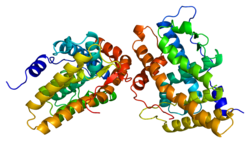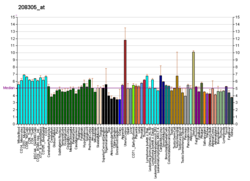
Back مستقبلات البروجسترون Arabic مستقبلات البروجسترون ARZ Progesteronski receptor BS PGR Welsh Progesteron-Rezeptor German Receptor de progesterona Spanish گیرنده پروژسترون Persian Récepteur de la progestérone French Receptor de proxesterona Galician プロゲステロン受容体 Japanese
The progesterone receptor (PR), also known as NR3C3 or nuclear receptor subfamily 3, group C, member 3, is a protein found inside cells. It is activated by the steroid hormone progesterone.
In humans, PR is encoded by a single PGR gene residing on chromosome 11q22,[5][6][7] it has two isoforms, PR-A and PR-B, that differ in their molecular weight.[8][9][10] The PR-B is the positive regulator of the effects of progesterone, while PR-A serve to antagonize the effects of PR-B.[11]
- ^ a b c GRCh38: Ensembl release 89: ENSG00000082175 – Ensembl, May 2017
- ^ a b c GRCm38: Ensembl release 89: ENSMUSG00000031870 – Ensembl, May 2017
- ^ "Human PubMed Reference:". National Center for Biotechnology Information, U.S. National Library of Medicine.
- ^ "Mouse PubMed Reference:". National Center for Biotechnology Information, U.S. National Library of Medicine.
- ^ Misrahi M, Atger M, d'Auriol L, Loosfelt H, Meriel C, Fridlansky F, et al. (March 1987). "Complete amino acid sequence of the human progesterone receptor deduced from cloned cDNA". Biochemical and Biophysical Research Communications. 143 (2): 740–8. doi:10.1016/0006-291X(87)91416-1. PMID 3551956.
- ^ Law ML, Kao FT, Wei Q, Hartz JA, Greene GL, Zarucki-Schulz T, et al. (May 1987). "The progesterone receptor gene maps to human chromosome band 11q13, the site of the mammary oncogene int-2". Proceedings of the National Academy of Sciences of the United States of America. 84 (9): 2877–81. Bibcode:1987PNAS...84.2877L. doi:10.1073/pnas.84.9.2877. PMC 304763. PMID 3472240.
- ^ ensembl.org, Gene: ESR1 (ENSG00000091831)
- ^ Gadkar-Sable S, Shah C, Rosario G, Sachdeva G, Puri C (2005). "Progesterone receptors: various forms and functions in reproductive tissues". Frontiers in Bioscience. 10 (1–3): 2118–30. doi:10.2741/1685. PMID 15970482.
- ^ Kase NG, Speroff L, Glass RL (1999). Clinical gynecologic endocrinology and infertility. Hagerstown, MD: Lippincott Williams & Wilkins. ISBN 978-0-683-30379-7.
- ^ Fritz MA, Speroff L (2005). Clinical gynecologic endocrinology and infertility. Hagerstown, MD: Lippincott Williams & Wilkins. ISBN 978-0-7817-4795-0.
- ^ Falcone T, Hurd WW (22 May 2013). Clinical Reproductive Medicine and Surgery: A Practical Guide. Springer Science & Business Media. pp. 39–. ISBN 978-1-4614-6837-0.
© MMXXIII Rich X Search. We shall prevail. All rights reserved. Rich X Search





